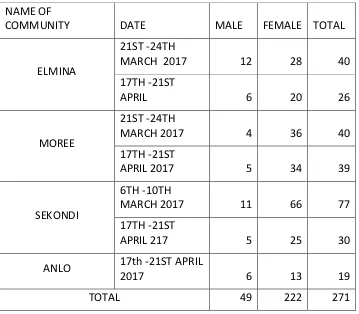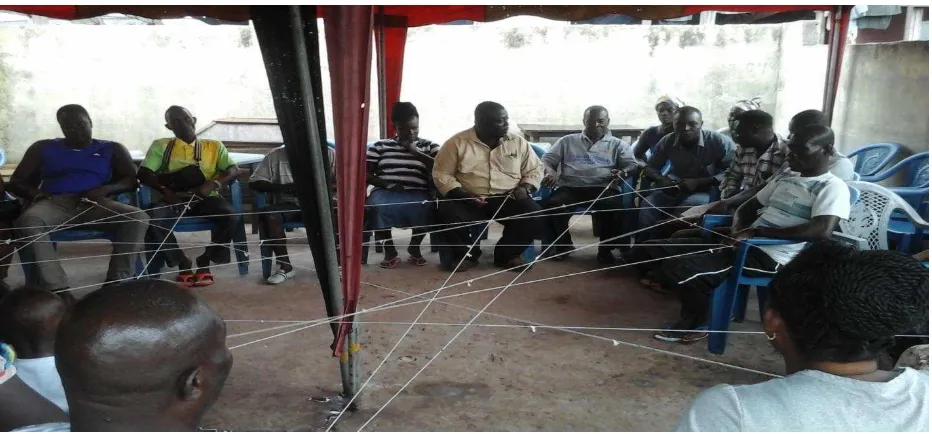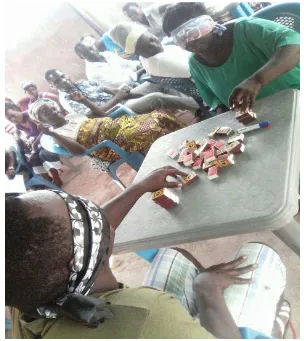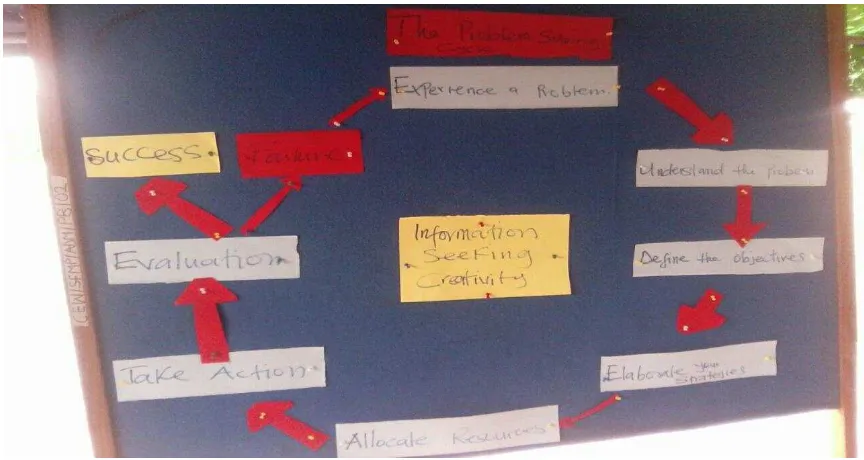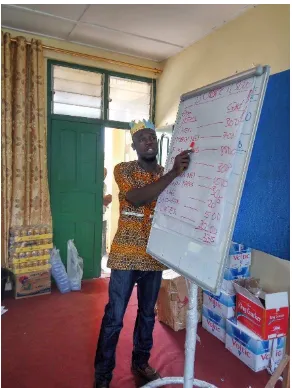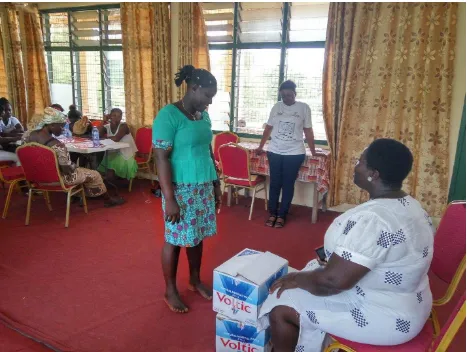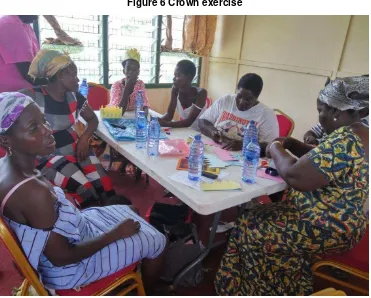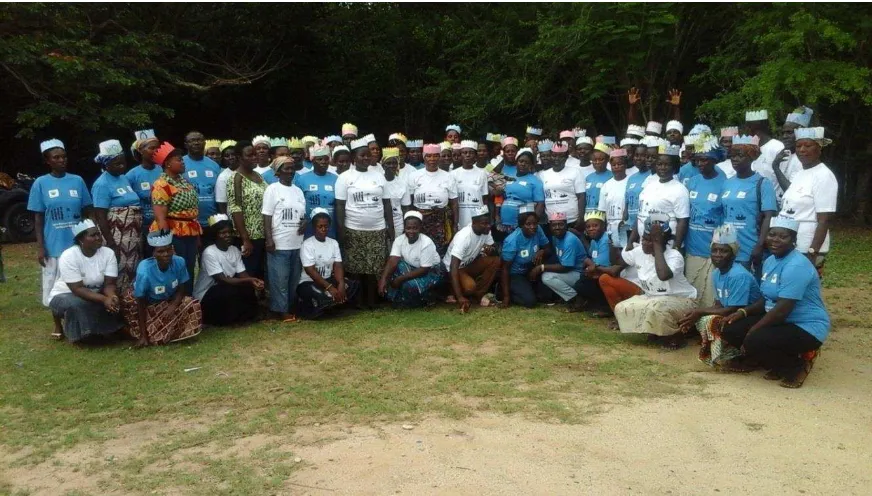SUSTAINABLE FISHERIES
MANAGEMENT PROJECT (SFMP)
Business Development Training for
MSMES in Moree, Elmina, and Anlo
This publication is available electronically in the following locations: The Coastal Resources Center
http://www.crc.uri.edu/projects_page/ghanasfmp/ Ghanalinks.org
https://ghanalinks.org/elibrary search term: SFMP USAID Development Clearing House
https://dec.usaid.gov/dec/content/search.aspx search term: Ghana SFMP
For more information on the Ghana Sustainable Fisheries Management Project, contact:
USAID/Ghana Sustainable Fisheries Management Project Coastal Resources Center
Graduate School of Oceanography University of Rhode Island
220 South Ferry Rd.
Narragansett, RI 02882 USA
Tel: 401-874-6224 Fax: 401-874-6920 Email: info@crc.uri.edu
Citation: CEWEFIA. (2017). Business Development Training for MSMES in Moree, Elmina, and Anlo. Ghana Sustainable Fisheries Management Project (SFMP). Narragansett, RI: Coastal Resources Center, Graduate School of Oceanography, University of Rhode Island and Central and Western Fish Mongers Improvement Association. GH2014_ACT102_CEW. 15 pp
Authority/Disclaimer:
Prepared for USAID/Ghana under Cooperative Agreement (AID-641-A-15-00001), awarded on October 22, 2014 to the University of Rhode Island, and entitled the USAID/Ghana Sustainable Fisheries Management Project (SFMP).
This document is made possible by the support of the American People through the United States Agency for International Development (USAID). The views expressed and opinions contained in this report are those of the SFMP team and are not intended as statements of policy of either USAID or the cooperating organizations. As such, the contents of this report are the sole responsibility of the SFMP team and do not necessarily reflect the views of USAID or the United States Government.
Detailed Partner Contact Information:
USAID/Ghana Sustainable Fisheries Management Project (SFMP) 10 Obodai St., Mempeasem, East Legon, Accra, Ghana
Telephone: +233 0302 542497 Fax: +233 0302 542498
Brian Crawford Chief of Party brian@crc.uri.edu
Najih Lazar Senior Fisheries Advisor nlazar@crc.uri.edu Patricia Mensah Communications Officer patricia.sfmp@crcuri.org
Bakari Nyari Monitoring and Evaluation Specialist hardinyari.sfmp@crcuri.org Don Robadue, Jr. Project Manager, CRC don@crc.uri.edu
Justice Odoi USAID Administrative Officer Representative Jodoi@usaid.gov
Kofi.Agbogah
SNV Netherlands Development Oganization #161, 10 Maseru Road,
E. Legon, Accra, Ghana 233 30 701 2440
Donkris Mevuta Kyei Yamoah info@fonghana.org Friends of the Nation Parks and Gardens Adiembra-Sekondi, Ghana 233 312 046 180
Peter Owusu Donkor Spatial Solutions
powusu-donkor@spatialdimension.net #3 Third Nautical Close,
Nungua, Accra, Ghana
Darkuman Junction, Kaneshie Odokor Highway
Accra, Ghana 233 302 315894
Gifty Asmah
giftyasmah@Daasgift.org Daasgift Quality Foundation
Headmaster residence, Sekondi College Sekondi, Western Region, Ghana 233 243 326 178
For additional information on partner activities: CRC/URI: http://www.crc.uri.edu CEWEFIA: http://cewefia.weebly.com/
DAA: http://womenthrive.org/development-action-association-daa Daasgift:
https://www.facebook.com/pages/Daasgift-Quality-Foundation-FNGO/135372649846101 Friends of the Nation: http://www.fonghana.org Hen Mpoano: http://www.henmpoano.org
SNV: http://www.snvworld.org/en/countries/ghana SSG Advisors: http://ssg-advisors.com/
TABLE OF CONTENTS
CONTENTS
TABLE OF CONTENTS ... iii
LIST OF FIGURES ... iii
LIST OF TABLES ... iii
INTRODUCTION ... 1
The Beneficiary ... 1
Training Team ... 3
Topics Treated ... 3
COST, PRICING AND COST CATEGORIZATION ... 6
BUDGETING ... 6
CUSTOMER SERVICE ... 7
FINANCIAL RECORD KEEPING (VARIOUS BOOKS) ... 8
PROFIT AND LOSS ANALYSIS (CROWN EXERCISE) ... 8
SAFETY, SANITATION AND ENVIRONMENT ... 10
TRAINING OUTCOME ... 10
CONCLUSION ... 10
RECOMMENDATION ... 11
EVALUATION OF TRAINING ... 11
CLOSING CEREMONIES ... 11
LIST OF FIGURES
Figure 1 A cross section of the participants using the twine exercise to introduce themselves 3 Figure 2 The Match Box Exercise ... 4Figure 3 Problem solving cycle depicted ... 6
Figure 4 Presentation on budgeting ... 7
Figure 5 Role play on Customer Service ... 8
Figure 6 Crown exercise ... 9
Figure 7 Participants in group planning their production ... 9
Figure 8 Group photograph of participants ... 10
INTRODUCTION
Small enterprises within the fishing sector in Ghana have been identified as a vehicle to deliver broad government policy objectives of poverty alleviation and income generation for the rural population through developing coastal fisheries. The fishing industry is confronted with many challenges. Central among them is the management of the fishing business itself as a means of generating sustainable income to increase their house hold income levels. Women play vital roles in the fisheries value chain and as such there is the need to develop their businesses. Nevertheless, these women are faced with risks and challenges that reduce their capital or cause them to lose their capital entirely. It is in view of this that CEWEFIA,
under the Sustainable Fisheries Management Project (SFMP), came on board to circumvent
the situation by supporting some women groups within selected fishing communities by
facilitating a Business Management Training Program to equip them in strengthening their
business and financial management capabilities. CEWEFIA has therefore organized a five-day business development training for MSMEs in Elmina, Moree, Anlo and Sekondi. This knowledge when gained will give the participants the right skills, knowledge and best
practices needed for business growth and ultimately increase profit and improve their
livelihood.
The Beneficiary
The Table below shows the number of participants who benefited from the training
Table 1 Number of participants who benefited from the training
Objective of training
The broad objective of the training is to improve the knowledge and skills of trainees in basic business management and practice in order to promote growth through the provision of effective training.
Specifically in:
Basic Business Management skills and competencies.
Entrepreneurial skills
Entrepreneurship capabilities.
Financial literacy and management among beneficiaries
Business purpose and operation
Systematic business planning
Cost and cost categorization
Financial record keeping (Various Books)
Profit and Loss Analysis
Fish quality control and processing
Sanitation
Fish preservation
Fish storage and packaging Needs assessment
Before the commencement of the training the trainers met with fish processers to discuss their training needs. A need assessment form was taken to collect data and this data was finally analyzed to ascertain the MSME specific knowledge gaps, and facilitated the design of appropriate intervention in terms of training materials suitable to achieve the goal. Training methodology
The Competency Based Economies Formation of Enterprise (CEFE) is a set of training instruments using action-oriented and experiential learning methods to enhance business management and personal competencies of a range of target groups. This approach is combined with participatory Rural/Learning Appraisal method.
Some of the tools include the following:
Brainstorming
Group discussions and presentations
Role plays
the various stakeholders in their business. The participants were made to throw a ball of twine to another and to mention their name, fears, expectations, objectives, likes and dislikes when the ball got to them. In the process, a net was created and the facilitator used it to explain to participants how a network was formed.
The question “who do we network with?” was used to help the trainees know how
networking is used to strengthen every business. In the process, the participants came to the conclusion that networking with all stakeholders involved in the fisheries sector will help improve their businesses.
Figure 1 A cross section of the participants using the twine exercise to introduce themselves
TRAINING TEAM
The facilitation team was made up of staffs of CEWEFIA who had undergone training in Business Management using the CEFE approach in teaching.
Topics Treated
Understanding Enterprise Environment
To understand the operations of an enterprise, participants were taken through the factors that affect enterprise activities and how they correlate. As a result participants were taken through the enterprise triangle which comprises the following:
The enterprise
The entrepreneur and
The environment
THE ENTERPRISE: The participants were taught that enterprise is any type of business that is involved in to provide goods and services for profit benefits.
SWOT stands for Strengths, Weaknesses, Opportunities and Threats. It is a way of
The participants were put into groups of four to analyze their business. The outcome was great since after the exercise they really understood where to bridge the gabs in their businesses.
THE ENTREPRENEUR: An Entrepreneur is the sole person responsible for the successful start and running of the business. Two participants were blindfolded and asked to build towers using match boxes. Other participants were asked to observe and comment later on their progress. The facilitator used this exercise to explain to participants the need to have passion for their businesses and also to be able to study the business environment before making a move.
A small sketch was put up by some of the participants to distract the attention of the two blindfolded women from building the towers. This sketch was done to let participants know that every business person must be focused. Distractions must be avoided when doing serious business.
Figure 2 The Match Box Exercise
The facilitator took participants through Personal Entrepreneurial Competencies and personal qualities as the key to success of an entrepreneur, such as:
Opportunity seeking and initiative
Persistence
Commitment to work contract
Demand for quality and efficiency
Calculated risk taking
Systematic planning and monitoring
Information seeking
Networking and persuasion
Innovativeness and resourcefulness
Independence and self confidence
Problem solving.
THE BUSINESS ENVIRONMENT
The business environment is where the business is found. The PEST model was used to make
Political Factors:
o Government policies,
o District bye laws
Economic Factors:
o Inflation
o demand
o consumption patterns, prices of fuel
o taxes
o loans- interest rate, etc
Social Factors-
o What is fashionable now and in future?
o Changing taste of consumers.
Technological Factors-
o Type of technology use,
o Is there other technology?
o Would training be needed to upgrade skills?
Systematic business Planning
Every business that anticipates growth must recognize planning as one of the essential management tools that has to be employed by every entrepreneur in achieving the growth. Failure to plan the business and its expansion often leads to collapse among the small businesses.
Figure 3 Problem solving cycle depicted
Participants were also taken through exercises that will help them set clear goals and objectives, motivating enough to spur entrepreneurs on in the face of challenges that might arise when trying to run their enterprises
COST, PRICING AND COST CATEGORIZATION
One major area of business that needs serious attention is costing. When it comes to costing small enterprises are found wanting. The participants were therefore introduced to costing, types and its categorization to enable fish mongers take all costs into consideration before coming out with prices for their produce. Simple ways of identifying the costs for fishing industry and its calculations have been established
Budgeting
Figure 4 Presentation on budgeting
CUSTOMER SERVICE
Figure 5 Role play on Customer Service
FINANCIAL RECORD KEEPING (VARIOUS BOOKS)
In this area, importance of record keeping was established, and its use to improve business. Various books relevant for small business were identified and taught how to keep them. Exercises were used to better appreciate how the entries are done.
PROFIT AND LOSS ANALYSIS (CROWN EXERCISE)
Figure 6 Crown exercise
Figure 8 Group photograph of participants
SAFETY, SANITATION AND ENVIRONMENT
Again beneficiaries learn about safety measures that needed to be adopted to ensure that work side accidents and incidents are minimized. We equally discussed personal and
environmental hygiene to avoid contamination once it is the food industry we are dealing with. Safety and sanitation issues need consideration right from processing stage to packaging and even to the point of sale.
Another critical segment is the effect of business activity on the environment. Businesses has to develop environmental consciousness about use of resources and allow for regeneration where possible and also conscious of smoke emission as a result of smoking, finding positive ways of disposing waste water.
TRAINING OUTCOME
The training ended with capacities of trainees built. It is hoped that participants would be in a position to use the knowledge gained in maximizing profits and also developing their
businesses.
CONCLUSION
RECOMMENDATION
We recommend that going forward CEWEFIA will source for funds to support participants with diversified livelihoods and non-formal education to help improve their socio-economic lives.
CEWEFIA also intends to provide target communities with Village Savings and Loans (VSLAs)
EVALUATION OF TRAINING
The participants used the mood barometer in evaluating the training, along the lines of evaluation framework. Pictures were drawn to represent the mood of participants, that is Happy, Indifferent and Sad; and trainees were asked to tick their mood in relation to areas of assessment.
